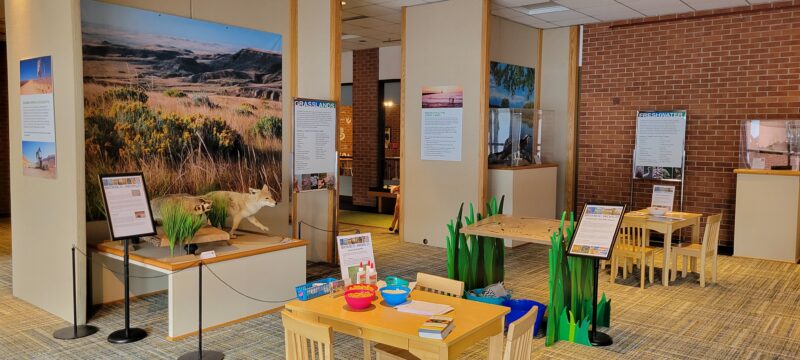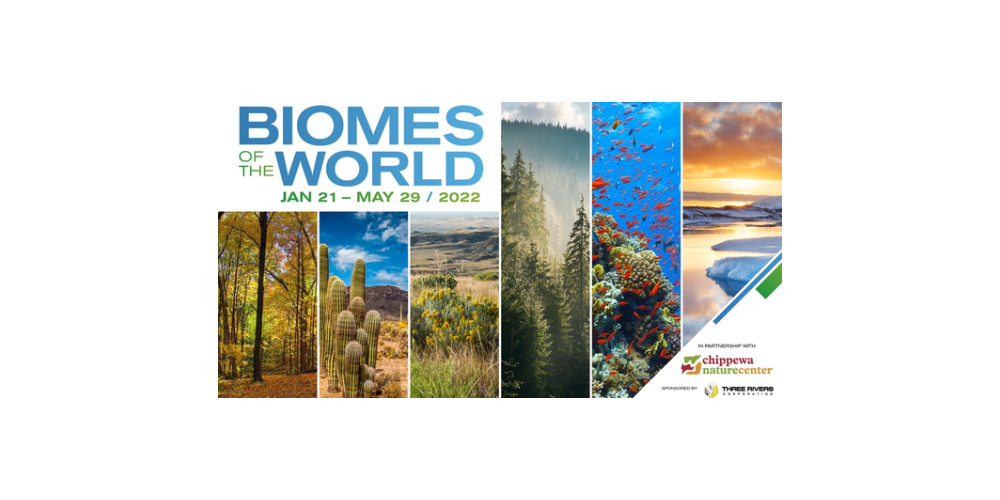STEM Pipeline Blog / March 8, 2022
Midland Center for the Arts: Discover the Biomes of the World with this New Exhibit and At-Home Experiment
As we look out the window and see the last remaining days of winter, we can fondly recall a beautiful series of cold months here in Michigan with snow that fell to the ground. What might feel familiar to each of us, is actually what makes where we live so unique and special. And what makes each and every region around the world special is in part due to its BIOME.
New Exhibit
In a new exhibit at Midland Center for the Arts, Biomes of the World, we are exploring several of the major biomes including aquatic, forests, grasslands, desert and tundra. So, what is a biome? They are a geoclimatic zone that is identifiable on a global scale and includes things such as plants and animals.
Here in Mid-Michigan, we live in a temperate deciduous forest, which means that we have four seasons and each autumn the beautiful colored leaves on our trees fall to cover the ground.
And when we think about each biome, there is a community of living organisms that thrive on the climate. In this exhibit at the Center, through a partnership with the Chippewa Nature Center, families can learn about the animals in each biome and even have an opportunity to interact with live animal ambassadors.

At-Home Experiment
So now that you understand what a biome is, here in Michigan there is that familiar attribute that is prevalent in our biome – SNOW. While you talk to your family about biomes, and prepare to visit the newest exhibit at Midland Center, try this experiment at home to understand the science and beauty behind the crystallization process that makes snow. Did we mention that just like snow, you can even EAT the results of this crystallization experiment? Give it a try!
Here are the materials you will need:
- Water
- Cup measurer
- Sugar
- Cooking pot
- Skewers
- Glass jars/cups
- Food coloring (optional)
- Candy flavoring (optional)
- Clothespins
- Paper towel
- Wax paper
Procedure:
- With the help or supervision of an adult, boil two cups of water over the stove in your pot.
- Next, stir in four cups of sugar. Continue to stir the solution, while still boiling, until the sugar is completely dissolved.
- If you choose, this is the time where you would add a few drops of flavoring to your solution. Vanilla extract is a great choice, and something most people have in their cupboards!
- Turn off the heat and remove the pot from the stove to cool.
- While your solution is cooling, wet your skewers and roll them in sugar. Skewers must dry completely before you move on to the next step.
- Add food coloring to your sugar solution, if desired.
- Transfer the cooled solution to your jars. You will need one jar for every skewer.
- Place one skewer in the middle of each jar, making sure it is not touching the sides. Use the end of the skewer to poke a hole in a piece of a paper towel, and cover the jar.
- Secure the skewer with a clothespin.
- Put your jars in a cool, quiet place for the crystallization process to occur. Let the candy crystalize, this can take up to two weeks!
- When you are satisfied with your candy, take the skewers out of the jars and place them on wax paper to dry.
Discussion:
All matter is made up of tiny particles called atoms and molecules. When a crystal forms, through a process called crystallization, the individual molecules are connecting in a repeating pattern. Common examples of crystals are gemstones, regular table salt and SNOW!
When we mix sugar and water, we create a solution. By heating up the water, we are allowing it to dissolve more sugar than it would at room temperature. This creates a supersaturated solution. As the sugar water cools, the sugar molecules start to “fall out” or precipitate out of the solution. The sugar we rolled onto our skewers acts as a guide, or seed crystals for the sugar in the solution to attach to.
Midland Center for the Arts Information
Location: 1801 W Saint Andrews Rd Midland, MI
Contact: (989) 631-8250
Website: https://www.midlandcenter.org/
Hours: Friday 12 – 4 PM, Saturday 10 AM – 2 PM and Sunday 12 – 4 PM
Admission: $3 per person and FREE for Museum Members
**The Midland Center is a participant in the STEM Passport App. Download app to learn more about the organization and other upcoming events.
Learn more: https://www.stempipeline.com/out-of-school-time/stem-passport-2020-2021/
← Blog Archives
